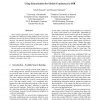Free Online Productivity Tools
i2Speak
i2Symbol
i2OCR
iTex2Img
iWeb2Print
iWeb2Shot
i2Type
iPdf2Split
iPdf2Merge
i2Bopomofo
i2Arabic
i2Style
i2Image
i2PDF
iLatex2Rtf
Sci2ools
IPPS
2007
IEEE
2007
IEEE
Using Linearization for Global Consistency in SSR
Novel routing algorithms such as scalable source routing (SSR) and virtual ring routing (VRR) need to set up and maintain a virtual ring structure among all the nodes in the network. The iterative successor pointer rewiring protocol (ISPRP) is one way to bootstrap such a network. Like its VRR-analogon, ISPRP requires one of the nodes to flood the network to guarantee consistency. Recent results on self-stabilizing algorithms now suggest a new approach to bootstrap the virtual rings of SSR and VRR. This so-called linearization method does not require any flooding at all. Moreover, it has been shown that linearization with shortcut neighbors has on average polylogarithmic convergence time, only.
Distributed And Parallel Computing | IPPS 2007 | Pointer Rewiring Protocol | Virtual Ring Structure | Virtual Rings |
Related Content
| Added | 03 Jun 2010 |
| Updated | 03 Jun 2010 |
| Type | Conference |
| Year | 2007 |
| Where | IPPS |
| Authors | Kendy Kutzner, Thomas Fuhrmann |
Comments (0)

